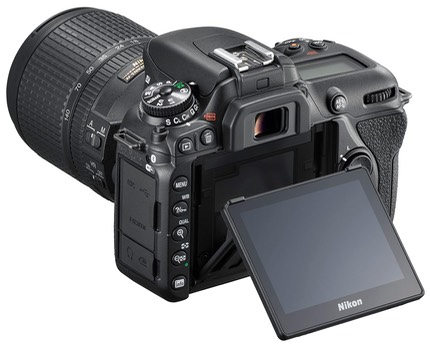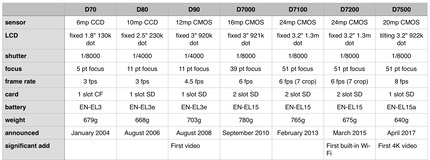
Nikon today announced the D7500, the model that replaces the D7200 in a venerable line of DSLRs, perhaps one of Nikon's most important camera lineages.
To refresh one's memory, here's the way that line has evolved:

Starting with the D70 in 2004, Nikon has come up with a fully refreshed version of this camera about every two years, and the D7500 is just the latest in that progression. This particular line of Nikon DSLRs sits right at the crossover between true consumer cameras—these days the D3xxx and D5xxx lines—and the true professional cameras—the D500 and the full frame models. As such, it is the "affordable choice" for serious shooters, as it juggles both price and feature sets in a way that arguably sits at a strong balance point for price/performance. This line answers the question "what Nikon DSLR do I buy if I want truly serious performance and features at a reasonable price?"
So let's take a look at what Nikon has and hasn't changed in this new model. The big changes come at the image sensor and rear LCD. We get the D500's 20mp sensor, which brings 4K video and a faster frame rate. Some may raise eyebrows at this sensor change, though I see it as mostly a smart move on Nikon's part. First, they're getting sensor re-use, which lowers costs. Second, while the D500 sensor doesn't raise the bar much over the D7200 sensor—and lowers it in the pixel count wars—my experience with it tells me it is a very small, but measurable step forward.
Meanwhile, the tilting LCD is a feature I've never understood why it isn't on every camera. Tilting is a low bar to achieve engineering- and cost-wise, but a useful feature for photographers. Arbitrarily withholding it on the D7200 model seemed wrong to me. Personally, I prefer the full articulation type moveable LCD—as it allows you to put the LCD in a protective state and swivel around to show to front of camera—but tilting is a close second.
The LCD is a good news, bad news story. Dot count is down. But menus are touch selectable. This is once again Nikon micromanaging parts in their design bin. It appears that they’ve elected to bring the ease-of-setting upwards from the D5xxx models, but eschew the high resolution monitors used in the D500 and D5.
The viewfinder gets a bit of a tweak, too, with less diopter range and a slightly lower eyepoint (18.5mm versus 19.5 in the D7200). Which brings me to a point: a lot of the changes in the D7500 over the former model are subtle. I don’t think people will find most of those changes problematic, but there’s definitely going to be a relearning curve even for D7200 users, something that didn’t really happen in the D7100 to D7200 transition.
As you might expect at this point, the D7500 also comes with SnapBridge, the Bluetooth/Wi-Fi combo that was supposed to simplify connecting to mobile devices but hasn't really. Still, Wi-Fi connectivity is now a must in cameras, and the D7500 joins the SnapBridge crowd. Let's just hope that SnapBridge isn't locked into a frozen time-warp, and gains stability, simplicity, and functionality over time.
Strangely, Nikon tends to avoid using the word SnapBridge in their press release and most marketing materials for the camera, opting to first mention Wi-Fi and Bluetooth and low-keying the SnapBridge mentions. Oh, SnapBridge does get mentioned (“Install Nikon’s SnapBridge app…”) in places in the marketing materials, and especially in the footnotes, but Nikon seems to have taken a step backward in promoting that SnapBridge trademark. Nikon got a lot of negative publicity with SnapBridge, and instead of acknowledging that, fixing it, and repromoting the fix, they seem to be all in their old course, but just only want to whisper the name now.
That said, there’s plenty to like in the update. An even bigger raw buffer (50 raw max at 8 fps and full resolution, or 100 JPEG). There’s a new Auto Picture Control. A slightly slimmer body with a deeper hand grip, and a slightly lower weight. The addition of Group AF mode and Auto AF Fine Tune. Interestingly, the addition of the 180k pixel exposure meter from the D5/D500. The RETOUCH menu gets a raw batch processing option. Unfortunately, there’s one thing to dislike in the new model: only a single UHS-I SD card slot. Oh, and this: there’s no mention of a vertical grip accessory at the moment, and the AI index pin appears to be gone.
Meanwhile, Nikon snuck the price up a bit here in the US to US$1249 for the body only. Shipment is only described as “summer 2017” at this point, not a confidence-inspiring date, as that technically means anywhere from June to August for us Northern Hemispheric types. Nikon risks losing sales if it isn’t out in June. Indeed, they’re already past the mark where some people are doing their summer planning and purchasing, though generally Father’s Day (June 18) is the traditional point where you need bodies on shelves.
The real question is this: how many folk will update their previous model in this line to the new one? I and others have been researching how often DSLR users are upgrading, with most of us coming up with a median update point between 2 and 2.5 generations. That means that it's critical for the D7500 to pick up some D90 and D7000 holdouts, some of which may have had their camera for almost 10 years. Indeed, the D90 was the top seller in this line and the D7000 came out right at pretty much the peak of DSLR sales overall. There are far more D90/D7000 users to convert to D7500’s than D7100/D7200 users.
Looked at in terms of that D90/D7000 group, the D7500 has a lot to offer: much better video, better focus, better LCD, better frame rate, built-in Wi-Fi, and more. Of course, the price differential on the the D7500 and the previous generation D7200 now makes that D7200 look pretty good to those folks, too, given the discounted price. So, yes, Nikon should win over a good block of D90/D7000 owners with the new camera.
The problem is that the specs really don't seem as compelling to D7100 and D7200 owners: the downgrade in sensor pixel count is the biggest thing that catches their attention, and I'd argue that the built-in WMU in the D7200 offers better integration into smartphones than the SnapBridge of the D7500 at the moment. So what would be the compelling feature that gets these folks to update? 4K video? Tilting touchscreen LCD? Frame rate?
The interesting thing is that the D7500 update falls somewhere between the D3400/D5600 updates and the D500 jump from the D300. The D3400 and D5600 were, best case, what would be called lukewarm updates; very little changed, and nothing changed of note. The D500 update was a massive "everything changes" update, and that got the immediate and total attention of those still clinging to hope for a D300 line.
The D7500 update isn't lukewarm, nor is it massive. It's just another strong, progressive step towards keeping the price/performance balance point in the Nikon DSLR lineup tuned with the times. Because of the sensor switch, in some ways the D7500 update has become the "less expensive D500" model. But remember, the line that the D7500 sits in is all about balance. Not only is it less expensive, but it also has a built-in flash unit that the all-performance D500 doesn't. That difference alone makes the D7500 an interesting camera for anyone pondering a D500.
I'm pretty sure there will be moaning and complaints and guffaws galore on the Internet about the D7500 as people find something to fault that Nikon didn't provide them. But I'm of a different mind here. I think Nikon did a very good job finding the right combination of things that save them cost, but still create a well-balanced product that sits at that important place in their lineup. Shooting with it will tell all, of course, but on paper the D7500 looks about like I expected it to, and moves a proud line another two years forward in time.
Support this site by purchasing from the following advertiser:





